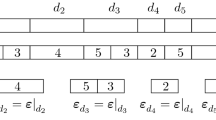Abstract
A discrete-time multitype branching process model is presented for the evolution of transposable elements in haploid populations. An individual is classified as type i if it possesses i copies of the TE, i⩾0. The general model incorporates copy-dependent selection and transposition, and recursion relations are derived for the distribution of the number of individuals of the various types. The asymptotic relative proportions of individuals of the different types is studied in the neutral case. The behavior of this equilibrium distribution is examined for various patterns of regulated transposition and deletion.
Similar content being viewed by others
References
Charlesworth, B., Charlesworth, D.: The population dynamics of transposable elements. Gen. Res. 42, 1–27 (1983)
Bingham, P. M., Kidwell, M. G., Rubin, G. M.: The molecular basis of P-M hybrid dysgenesis: the role of the P element, a P-strain specific transposon family. Cell 29, 995–1004 (1982)
Doolittle, W. F., and Sapienza, C.: Selfish genes, the phenotype paradigm and genome evolution. Nature 272, 123–124 (1980)
Gantmacher, F. R.: The theory of matrices, 2nd vol. New York: Chelsea 1959
Harris, T. E.: The theory of branching processes. Berlin Heidelberg New York: Springer 1963
Kleckner, N.: Transposable elements in prokaryotes. Ann. Rev. Gen. 15, 341–404 (1981)
Langley, C. H., Brookfield, J. F. Y., Kaplan, N.: Transposable elements in Mendelian propulations I. A theory. Genetics 104, 457–471 (1983)
Montgomery, E. A., Langley, C. H.: Transposable elements in Mendelian populations II. Distribution of three copia-like elements in a natural population of Drosophila melanogaster. Genetics 104, 473–483 (1983)
Ohta, T., Kimura, M.: Some calculations on the amount of selfish DNA. PNAS 78, 1129–1132 (1981)
Ohta, T.: Population genetics of selfish DNA. Nature 292, 648–649 (1981)
Orgel, L. E., Crick, F. H. C.: Selfish DNA: the ultimate parasite. Nature 284, 604–607 (1980)
Rose, M. R., Doolittle, W. F.: Molecular biological mechanisms of speciation. Science 220, 157–161 (1983)
Rubin, G. M., Kidwell, M., Bingham, P. M.: The molecular basis of P-M hybrid dysgenesis: the nature of induced mutations. Cell 29, 987–994 (1982)
Brookfield, J. F. Y.: A model for DNA sequence evolution within transposable element families. Genetics 112, 393–407 (1986)
Kaplan, N., Darden, T., Langley, C. J.: Evolution and extinction of transposable elements in Mendelian populations. Genetics 109, 459–480 (1985)
Ohta, T.: Population genetics of an expanding family of mobile genetic elements. Genetics 113, 145–159 (1986)
Sawyer, S., Hartl, D.: Distribution of transposable elements in prokaryotes. Theor. Popul. Biol. 30, 1–16 (1986)
Slatkin, M.: Genetic differentiation of transposable elements under mutation and unbiased gene conversion. Genetics 110, 145–158 (1985)
Author information
Authors and Affiliations
Rights and permissions
About this article
Cite this article
Moody, M.E. A branching process model for the evolution of transposable elements. J. Math. Biology 26, 347–357 (1988). https://doi.org/10.1007/BF00277395
Received:
Revised:
Issue Date:
DOI: https://doi.org/10.1007/BF00277395



